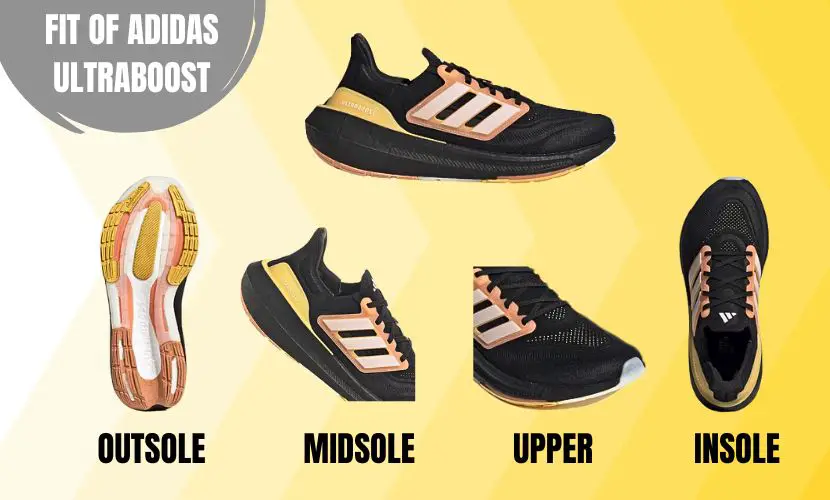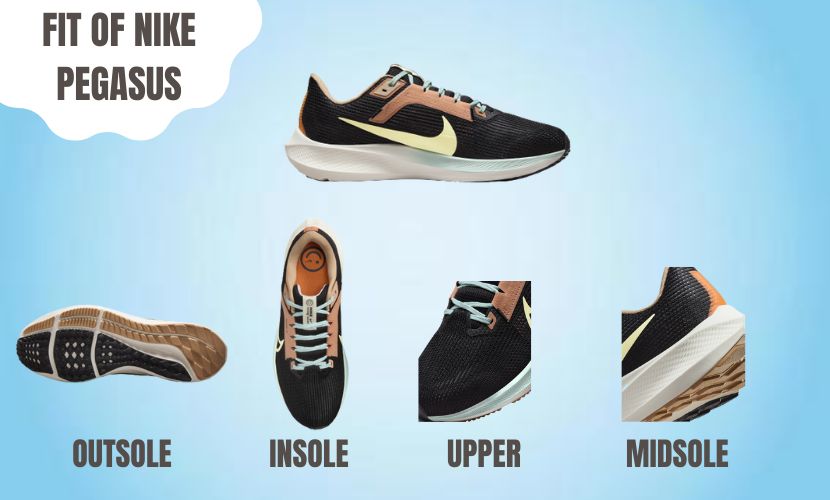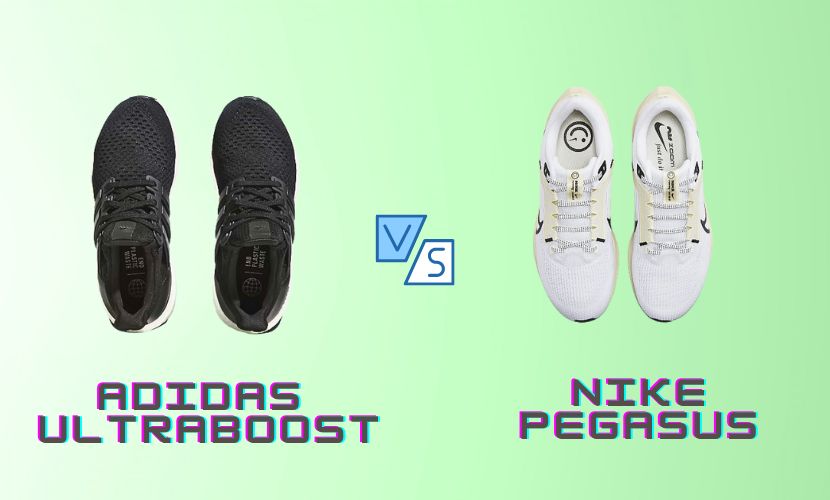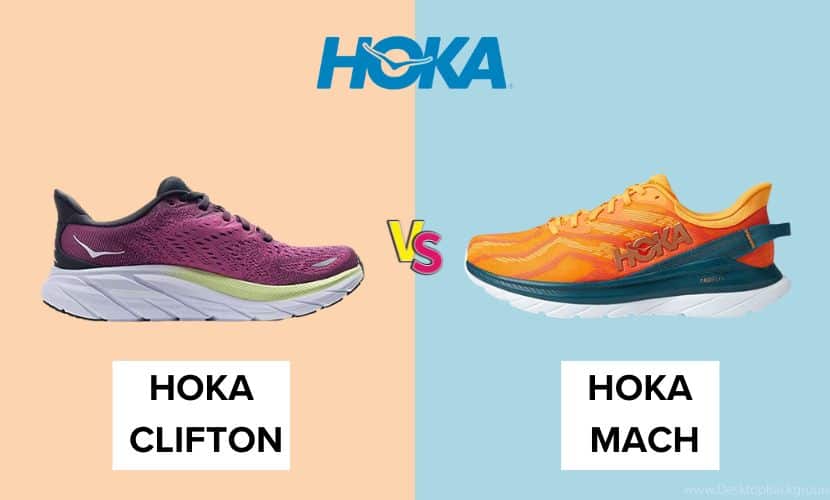Nike Pegasus and Adidas Ultraboost are two of the most famous running shoes in the industry today. Both shoes contain a loyal following of athletes who swear by their particular brands. However, knowing which shoe is the perfect fit for you can be challenging when selecting between the two.
The Nike Pegasus is a good running shoe famous for its iconicness and affordability. It is a renowned option among runners of all standards, from beginners to experts. The shoe is structured to offer a comfortable and reactive ride, with a padded midsole and a permeable upper. The Pegasus is also accessible in colors and styles, making it a famous option for runners who desire to express their style.
The Adidas Ultraboost, on the other side, is a standard running shoe popular for its opulent feel and upgraded technology. The shoe provides Adidas’ trademark Boost technology, which offers a reactive and padded ride. The Ultraboost is also constructed with a porous and stretchable Primeknit upper, which conforms to the foot’s appearance for a customized fit. The shoe is obtainable in various colors and styles, making it a famous option for runners wanting to create a fashion statement while running.

Comparison Table: Adidas Ultraboost Vs Nike Pegasus
| Feature | Adidas Ultraboost | Nike Pegasus |
| Cushioning | Boost technology for responsive feel | Nike Zoom Air cushioning |
| Fit | Slightly narrow fit | Comfortable fit |
| Weight | Heavier (10.9 oz) | Lighter (9.4 oz) |
| Price | Higher cost | More affordable |
| Durability | Durable construction | Durable materials |
| Performance | Luxurious padding, reactive | Responsive and cushioned |
| Style | Modern and stylish design | Iconic and versatile design |
| Long-Distance | Suitable for long-distance running | Suitable for various activities |
| Breathability | Primeknit upper for breathability | Engineered mesh for air circulation |
| Support | Stable with precise foot lockdown | Supportive and comfortable |
Product Specifications

Adidas Ultraboost Features
The Adidas Ultraboost is a standard running shoe structured for long-distance running. The following are several significant features:
- Boost Technology: The Ultraboost offers Adidas’ proprietary Boost technology, which gives remarkable padding and energy backup.
- Primeknit Upper: The shoe’s upper is designed of Adidas’ Primeknit material, a stretchable and porous knit fabric that adapts to the foot’s appearance.
- Continental Rubber Outsole: The Ultraboost’s outsole is engineered of Continental Rubber, giving remarkable grip on damp and dry surfaces.
- Torsion System: The shoe features additional support and steadiness in the midfoot area.
- Heel Counter: The Ultraboost offers a molded heel counter that aids in maintaining the foot in position during running.
Nike Pegasus Features
The Nike Pegasus is an iconic running shoe adaptable for regular training. The following are several significant features:
- Nike Zoom Air Cushioning: The Pegasus provides Nike’s Zoom Air padding, which offers a reactive and snug ride.
- Engineered Mesh Upper: The shoe’s upper is designed of an engineered netting material that gives permeability and aid where it’s required most.
- Flywire Cables: The Pegasus offers Flywire cables that amalgamate with the laces to give a safe and supportive fit.
- Full-Length Cushlon Foam: The shoe’s midsole is designed of a whole-length Cushlon foam that offers a mushy and reactive ride.
- Rubber Outsole: The Pegasus’ outsole is constructed of a hard-wearing rubber material that gives grip and durability.
Overall, the Adidas Ultraboost and Nike Pegasus are outstanding running shoes that provide a lot of value for their cost. The Ultraboost is more adaptable for elongated-distance running and features excellent padding and energy backup; on the contrary, the Pegasus is more classic and perfect for regular training.
Performance Comparison

Regarding performance, both Adidas UltraBoost and Nike Pegasus provide excellent attributes. Following is a breakdown of how they contrast in comfort, longevity, traction, and reactiveness.
Comfort
Both shoes are snug, but the Adidas UltraBoost emerges with its versatile Boost technology that gives a luxurious and reactive feel. Conversely, the Nike Pegasus provides a more customary padding system that is snug but less springy than the UltraBoost.
Regarding permeability, both shoes have absorbent uppers that permit good air circulation and temperature regulation. However, the UltraBoost contains a Primeknit upper that is more stretchable and adapts to the foot, offering a more sock-like fit.
Durability
Regarding durability, the Adidas UltraBoost is famous for its durable construction. The Boost midsole is popular to retain its appearance and reactiveness even after elongated use. The upper is also designed from top-quality materials that can resist deterioration.
The Nike Pegasus is also hard-wearing, but some wearers have mentioned that the padding system loses its reactiveness after elongated use. The upper is designed from a fusion of fabricated and netting materials that are hard-wearing but less vigorous than the UltraBoost’s Primeknit.
Traction
Both shoes provide remarkable traction on various surfaces, incorporating pavement, gravel, and debris. The Adidas UltraBoost contains a Continental rubber outsole that offers superior traction, even in damp conditions. The Nike Pegasus comprises a rubber outsole with a waffle design that provides good grip but less than the UltraBoost.
Responsiveness
The Adidas UltraBoost is famous for its reactiveness, thanks to its Boost technology that offers a springy and energetic feel. The Nike Pegasus also provides good reactiveness but less than the UltraBoost. Several wearers have mentioned that the Pegasus feels a bit stagnant compared to the UltraBoost.
Both shoes provide remarkable performance, but the Adidas UltraBoost emerges in the case of comfort, longevity, traction, and reactiveness. The Nike Pegasus is also a fantastic choice for those searching for a more customary padding system and a moderately lower price point.
Aesthetics and Design
Regarding aesthetics and pattern, both Adidas Ultra Boost and Nike Pegasus contain their versatile styles. Following is a breakdown of their patterns:
Adidas Ultra Boost
The Adidas Ultra Boost contains a streamlined and modern design ideal for those wanting to create a fashion statement while running. The shoe offers a whole recycled upper and a sturdy design created to last. The shoe is accessible in various colors, incorporating black, white, and grey. The Ultra Boost contains an authoritative appearance with the three bands on the edge and the Boost midsole.
Nike Pegasus
The Nike Pegasus contains an iconic pattern that has been upgraded over the years to continue with the newest trends. The shoe is accessible in various colors, incorporating black, white, and grey. The Pegasus contains a plain appearance with the Nike swoosh on the edge and the Air Zoom midsole.
Comparison
Both shoes contain versatile pattern elements that attract different athletes. The Adidas Ultra Boost contains a more modern and voguish look; on the contrary, the Nike Pegasus has an iconic and plain pattern.
Regarding fit, the Adidas Ultra Boost contains a precise foot lockdown and a finer fit for women; on the other side, the Nike Pegasus has a broader fit that shelters a diversity of foot shapes. Testing both shoes to detect which fits finer and feels more snug is necessary.
Material Comparison

Both Adidas Ultra Boost and Nike Pegasus use top-standard materials in their formation. However, several noteworthy differences may influence an athlete’s experience.
Adidas Ultra Boost
The Adidas Ultra Boost offers a Primeknit upper, a coherent and flexible material that adapts to the foot for a snug, sock-like fit. The upper is also permeable, which aids in keeping the foot cool, fresh, and dry during runs. The shoe’s midsole is designed with Adidas’ proprietary Boost foam, which offers remarkable padding and energy backup. The outsole is structured with Continental rubber, providing good grip and durability.
Nike Pegasus
The Nike Pegasus offers a netting upper, a delicate and absorbent material that permits good air circulation to the foot. The upper also incorporates Flywire cables, which cover around the midfoot for a safe and supportive fit. The shoe’s midsole is designed of Nike’s React foam, which is mushy and reactive, offering good padding and energy backup. The outsole is designed of a hard-wearing rubber material that provides good grip.
Overall, both shoes use top-quality materials that feature good performance and ease. The Adidas Ultra Boost’s Primeknit upper may provide a more cozy and snug fit; on the contrary, the Nike Pegasus’ netting upper may offer finer permeability. The Adidas Ultra Boost’s Boost foam midsole may provide superior padding and energy backup; on the other side, the Nike Pegasus’ React foam midsole may give a mushier and more reactive feel.
Price Comparison
Concerning the price, there is a noteworthy difference between the Nike Pegasus and the Adidas Ultra Boost. The Pegasus is a more economical choice; on the contrary, the Ultra Boost is a more costly, opulent shoe.
The newest model of the Nike Pegasus costs around $120; on the other side, the Adidas Ultra Boost is priced at approximately $180. This is an efficient difference in price, but it is necessary to mention that the Ultra Boost offers a versatile boost technology for advanced padding, which may justify the more significant price for some athletes.
However, the Nike Pegasus is a fantastic option for those searching for a more budget-friendly choice. It offers a customary foam midsole and an iconic pattern, making it adaptable for regular running.
It is also worth mentioning that both shoes are available on sale at different times throughout the year, so it is always a perfect idea to observe for deals and discounts.
While the Adidas Ultra Boost may be a more costly choice, it provides versatile attributes that may be worth the investment for several athletes. However, the Nike Pegasus is perfect for a more economical, classic running shoe.
Weight Comparison
Concerning running shoes, weight is an obligatory factor to consider. The more delicate the shoe, the less energy the athlete has to expend to raise their feet off the ground, resulting in less tiredness and upgraded performance. In this part, we will contrast the weight of the Adidas Ultraboost and Nike Pegasus.
The Nike Air Zoom Pegasus 40 weighs approximately 9.4 ounces; on the other side, the Adidas Ultraboost Light weighs 6 ounces. This shows that the Ultraboost is lighter than the Pegasus, making it an excellent option for runners who value a feathery shoe.
However, it is necessary to mention that weight is not the only factor to contemplate when selecting a running shoe. The padding and support the shoe gives also play a critical role in detecting its performance and comfort.
In addition, it is also worth noting the athletes’ weight. A massive runner may take advantage of a more supportive and padded shoe; conversely, a lighter runner may prioritize a more unembellished and delicate shoe.
Overall, while the Adidas Ultraboost is more feathery than the Nike Pegasus, it is obligatory to consider other points, like padding and support, when selecting a running shoe.
Stack Height & Heel Drop
When contrasting running shoes, stack height, and heel drop are two necessary factors to examine. Stack height consults the thickness of the midsole; on the other side, heel drop computes the dissimilarity in height between the heel and forefoot. These factors can influence the overall ease and performance of a shoe.
The Adidas Ultraboost contains a stack height of 29mm in the heel and 19mm in the forefoot, proceeding in a heel-to-toe drop of 10mm. Conversely, the Nike Pegasus comprises a stack height of 28mm in the heel and 18mm in the forefoot, resulting in a 10mm drop. Both shoes provide a similar standard of padding and aid, with the Ultraboost containing a moderately massive midsole.
Regarding heel drop, some athletes prioritize a more significant drop for additional steadiness and support; on the other hand, others agree on a more profound drop for a more innate feel. The 10mm drop of the Ultraboost and Pegasus is an ideal middle surface that should be snug for most athletes.
It’s worth mentioning that both shoes are available in distinct variations with differing stack heights and heel drops. For instance, the Nike Pegasus Trail contains a greater stack height and drop for extra protection on irregular terrain. It’s necessary to consider the particular model and intended use when contrasting stack height and heel drop.
In summary, the Adidas Ultraboost and Nike Pegasus provide a similar standard of padding and support with a 10mm drop. While stack height and heel drop are obligatory factors to consider, it’s also necessary to consider the shoe’s particular model and intended use.
What are the critical differences between Adidas Ultraboost and Nike Pegasus?

Concerning running shoes, the Adidas Ultraboost and Nike Pegasus are two of the most famous choices in the industry. Both shoes contain versatile attributes that adapt to different kinds of athletes. The following are several significant dissimilarities between the two:
Cushioning
One of the most efficient differences between the Adidas Ultraboost and Nike Pegasus is their padding technology. The Ultraboost provides Adidas’ Boost technology with a springy and reactive feel. On the other side, the Pegasus uses a customary foam midsole, which provides a mushier and more padded ride.
Fit
Another dissimilarity between the two shoes is their fit. The Nike Pegasus contains a tight fit, perfectly matched for athletes with tight feet. The Ultraboost, on the other side, has a broader fit that adapts players with broader feet.
Weight
Regarding weight, the Nike Pegasus is more delicate than the Adidas Ultraboost. The Pegasus weighs approximately 9.4 ounces; on the other side, the Ultraboost weighs 10.9 ounces. This makes the Pegasus a finer choice for athletes who prefer feathery shoes.
Price
The Adidas Ultraboost is a more costly shoe compared to the Nike Pegasus. The Ultraboost retails for approximately $180; on the other hand, the Pegasus costs approximately $120. This cost difference makes the Pegasus a more economical choice for athletes on a budget.
Which shoe is better for long-distance running, the Adidas Ultraboost or Nike Pegasus?
Regarding long-distance running, ease, and support are obligatory factors to contemplate. Adidas Ultraboost and Nike Pegasus are famous options among runners, but which is better for long-distance running?
Adidas Ultraboost
The Adidas Ultraboost is famous for its snug and stable padding, making it an excellent long-distance running choice. The shoe offers a recycled upper, eco-friendly and hard-wearing enough to last through extended runs. The Ultraboost also contains a precise foot lockdown, offering a finer fit for women.
However, some athletes may discover the shoe a little tight and heavy, and it may not be as reactive as other choices in the industry. Furthermore, the Ultraboost has a top price tag, which may only be adaptable for some budgets.
Nike Pegasus
The Nike Pegasus is an iconic running shoe that balances ease and support perfectly. Its economical price point makes it a famous choice for athletes of all standards. The Pegasus offers a reactive padding system that gives a snug ride, making it an ideal choice for long-distance running.
The shoe also contains a permeable upper, which aids in maintaining feet excellent, fresh, and dry during elongated runs. However, several athletes may discover the shoe needs more steadiness and support, particularly for those with overpronation.
Overall, Adidas Ultraboost and Nike Pegasus are perfect for long-distance running. Athletes who prefer comfort and steadiness may agree on the Ultraboost; conversely, those who prefer affordability and reactiveness may go for the Pegasus.
What are the pros and cons of the Adidas Ultraboost compared to the Nike Pegasus?
When contrasting Adidas Ultraboost and Nike Pegasus, it is necessary to consider the advantages and disadvantages of every shoe to detect which one is best matched for the person’s requirements. The following are a few points to consider:
Adidas Ultraboost Pros
- Comfort: Adidas Ultraboost is famous for its snug padding, giving athletes an opulent ride.
- Style: The Adidas Ultraboost is a modish shoe that appears excellent on and off the ground.
- Durability: The sturdy pattern of the Ultraboost is designed to last, and the wholly recycled upper is an environmentally friendly bonus.
Adidas Ultraboost Cons
- Price: The Adidas Ultraboost is an exclusive shoe with a great price tag.
- Narrow Fit: Several athletes may discover the Ultraboost to be a little tight, which can be uncomfortable for those with broader feet.
- Weight: The Ultraboost is still a comparatively massive shoe, which may be challenging for runners searching for a delicate choice.
- Responsiveness: While the Ultraboost is snug, it may not be as reactive as other shoes in the industry.
Nike Pegasus Pros
- Versatility: The Nike Pegasus is an iconic shoe that can be utilized for various activities, from running to cross-training.
- Price: The Pegasus is a more economical choice compared to the Ultraboost.
- Breathability: The netting upper of the Pegasus permits good air circulation, keeping feet cool, fresh, and dry.
- Cushioning: The Pegasus offers good padding for a snug ride.
Nike Pegasus Cons
- Fit: Several players may discover the fit of the Pegasus to be a bit loose, which can be uncomfortable for those who prioritize a comfortable fit.
- Style: While the Pegasus is a practical shoe, it may not be as modish as other choices in the industry.
- Durability: The Pegasus may be easier to wear than other shoes and deteriorate more rapidly with daily use.
How does the Adidas Ultraboost Light compare to the Nike Pegasus?
Concerning running shoes, both the Adidas Ultraboost Light and the Nike Pegasus are famous options. The following is how they compare:
Comfort and Cushioning
The Adidas Ultraboost Light provides the latest midsole foam, giving decent padding for regular running. However, it must still be mushy than the Nike Pegasus, which has a customary foam midsole.
The Ultraboost Light also comprises a broader fit contrasted to the tight fit of the Pegasus, which may influence comfort for some athletes.
Weight and Durability
The Ultraboost Light is 30% more feathery than its predecessor, making it a good choice for runners who prefer delicate shoes. However, the Nike Pegasus is still lighter, with a more practical configuration that makes it more lightweight than the Ultraboost Light. Regarding durability, both shoes are well-designed and can resist regular use.
Running Distance
The Nike Pegasus is adaptable for everyday running; however, the Adidas Ultraboost Light is structured for long-distance running. This is because of the Ultraboost Light’s versatile boost technology, which features advanced padding for longer runs.
However, the Pegasus can still hold its own for elongated runs and is an iconic choice for runners of all standards.
Conclusion
The Adidas Ultra Boost provides snug and sturdy padding, precise foot lockdown, and a stable pattern. However, some athletes may discover the shoe a little tight, heavy, and not very reactive. Furthermore, the shoe is available with a great price tag.
Conversely, the Nike Pegasus offers a smooth, reactive ride with remarkable padding. The midsole is structured of padding foam; conversely, the outsole is constructed of durable rubber for grip and steadiness. The shoe is also accessible at a very compelling cost, making it an attractive choice for athletes on a budget. However, several athletes may discover the fit to be loose.
When it comes down to it, both shoes deliver in the matter of performance and ease. It is suggested that athletes test on both shoes and take them for a test run to detect which one feels perfect for their requirements.
Read more on:




